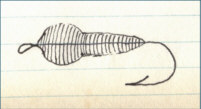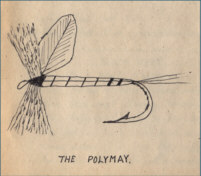Favourite Flies for the River Clyde (continued)
OLIVER KITE'S COPPER WIRE NYMPH
Size 18 hook and copper wire

WOODCOCK SEDGE
by D.J. Davies
Hook:
Size 13
Body:
Plumpish, bright plum-coloured filament nylon dubbed roughly
Wing:
Woodcock primary, long and low
Legs:
Two turns of natural, small black hackle
This was my discovery: so long as the fly
floated naturally, it was ignored, but as soon as it began to drag, it would be
attacked in seconds.
THE "POLYMAY" MAYFLY
by Richard Walker
SPENT FEMALE
Wings:
Blue Dun cock hackle points set on flat
Hackle:
Furnace cock
Body:
Plain polyethylene foam, nor covered
Silk:
Including ribbing, dark brown
Tails: Pheasant-tail fibres dyed dark
sepia
FEMALE SUB IMAGO
|
Wings:
White cock hackle points dyed pale sea-green set vertical
Hackle:
Two turns brown partridge, plus several turns ginger cock, long in the fibre
Body:
Polyethylene foam covered with overlapping turns of a narrow strip of straw
coloured raffene, dampened before it is would on
Silk:
Including ribbing, medium brown
Tails:
Natural pheasant tail
|
|
 |
The procedure is first to tie in wings
and hackles with their stalks lying along the hook shank, pointing towards the
bend. These stalks are cut off just short of where the hook bend commences. At
that point, the tails, ribbing and outer body material, if any, are tied in and
the silk taken back to the shoulder of the fly. Here a strip of polyethylene
foam is tied in. The strip is wound to the tail-roots and then back, over the
first turns, to the shoulder, giving a double thickness. Then the outer body
material, which is a narrow strip of raffene, is wound over the body and
secured, followed by the ribbing. The ribbing near the tail can with advantage
consist of two sets of four or five close turns before the open spiral
commences. The wings are then set up and the hackles wound in the normal way.
Polyethylene foam is buoyant and if a fine wire, long shank size 10 hook is
used, the resultant artificial has splendid floating properties. But despite the
buoyancy of the body, they will benefit from a dressing of silicone-wax floatant.
THE JULY DUN
This is a small dark olive dun which, as
its name suggest, most often makes its appearance on the water in July, or
 possible August. Because of its smallness it is often mistaken for the Iron Blue
Dun. It is a very old pattern and is most often used as a dry fly, to be floated
over trout or grayling. The tail of this fly consists of several fibres of
medium olive cock, the same feather being used for the hackle. For the body use
a piece of heron herl dyed yellow, and rib this evenly with the finest gold
wire. Try to give the fly a thinnish look and tie it on very small hooks never
larger than size 16 (old number). The wings, which should be short enough to
correspond with the minuteness of the natural fly, are made from strips of very
dark starling. Some fly dressers use single wings while others prefer to have
them doubled, but the latter, I think, make for a rather bulky fly, when the
natural is comparatively small. You can dress a hackled version of the July Dun
by using the same body and setae but a darkish dun cock for the hackle. For the
spinner you can use gold coloured floss, ribbed with fine gold wire, for the
body. The hackle is ginger cock, as are the setae, and the wing is pale starling
or bunched fibres of blue dun cock. possible August. Because of its smallness it is often mistaken for the Iron Blue
Dun. It is a very old pattern and is most often used as a dry fly, to be floated
over trout or grayling. The tail of this fly consists of several fibres of
medium olive cock, the same feather being used for the hackle. For the body use
a piece of heron herl dyed yellow, and rib this evenly with the finest gold
wire. Try to give the fly a thinnish look and tie it on very small hooks never
larger than size 16 (old number). The wings, which should be short enough to
correspond with the minuteness of the natural fly, are made from strips of very
dark starling. Some fly dressers use single wings while others prefer to have
them doubled, but the latter, I think, make for a rather bulky fly, when the
natural is comparatively small. You can dress a hackled version of the July Dun
by using the same body and setae but a darkish dun cock for the hackle. For the
spinner you can use gold coloured floss, ribbed with fine gold wire, for the
body. The hackle is ginger cock, as are the setae, and the wing is pale starling
or bunched fibres of blue dun cock.
Next page
|